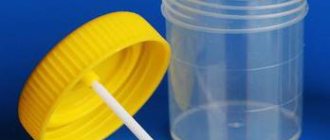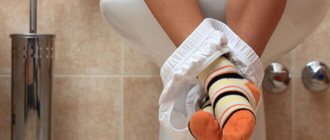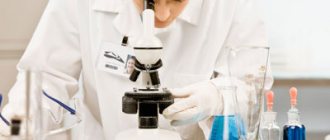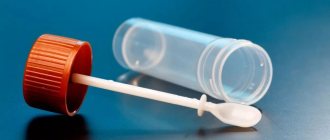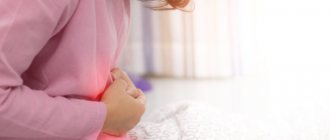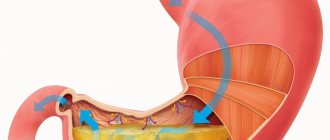What you need to know
In order for the study to show reliable information and not have to be repeated, before collecting biomaterial it is necessary to understand how to carry it out correctly and under what conditions to store feces for analysis. Experts warn that the requirements depend on which test is prescribed for the patient.
When issuing a referral, the doctor must explain in detail what rules need to be followed, whether the biomaterial can be stored in the refrigerator, at what temperature and for how long. If the patient has the opportunity, it is better to take the stool to the laboratory immediately after the morning bowel movement.
This is due to the fact that by studying a fresh sample, you can obtain the maximum amount of information. If emptying occurred in the evening, and the biomaterial needs to be delivered to the medical center in the morning, it can only be stored in the refrigerator. If the patient is scheduled for a biochemical study, the biomaterial may be stored in the freezer.
About stool tests
Poo (or feces) is usually thought of as nothing more than waste—something that can be quickly flushed away.
But bowel movements can give doctors valuable information about what's wrong when a baby has problems in the stomach, intestines or another part of the gastrointestinal system. Your doctor may order a stool collection to test for a variety of possible conditions, including:
- an allergy or inflammation in the body, such as part of the evaluation for milk protein allergy in infants
- an infection caused by certain types of bacteria, viruses, or parasites that invade the gastrointestinal system
- digestive problems, such as malabsorption of certain sugars, fats or nutrients
- bleeding inside the gastrointestinal tract
The most common reason for stool testing is to determine whether a type of bacteria or parasite may be infecting the intestines. Many microscopic organisms living in the intestines are necessary for normal digestion. However, if the intestines are infected with harmful bacteria or parasites, it can cause problems such as some types of bloody diarrhea, and a stool test can help find the cause.
Stool samples are also sometimes analyzed to see what they contain; for example, fat content is examined. Normally, fat is completely absorbed from the intestines, and stool contains virtually no fat. However, in some types of digestive disorders, fat is not completely absorbed and remains in the stool.
How to collect
Specialists from the laboratory recommend remembering and adhering to the following rules. It is strictly forbidden to do enemas 3 days before the tests. Only naturally obtained biomaterial is suitable for research. Before collecting feces, it is recommended to stop taking medications, including sorbents and laxatives, for 3 days.
If the patient takes any medications on an ongoing basis, the attending physician must be notified about this. The day before the procedure, it is prohibited to use rectal suppositories. When referred for some tests, the patient will have to adhere to a special diet for 7 days.
As a rule, it involves avoiding fatty and fried foods, pickles and smoked foods, and foods with a lot of spices and seasonings. These days, the basis of the patient’s diet should be fermented milk products and vegetables. If you are scheduled to take an occult blood test, you must limit your intake of foods containing iron.
If a stool test is performed on an infant, the mother is not recommended to introduce new foods into the diet.
To ensure that the analysis result is as accurate as possible, it is important to follow these rules:
- Feces are collected for analysis only after urination. If urine gets into the sample, the result may be distorted. This rule applies to adults and children.
- Before collection, it is necessary to carry out hygiene of the intimate area, including the anus. The procedure is carried out using warm water and regular soap.
- Defecation is carried out over a clean and dry container, after which part of the sample is transferred to a special sterile container. A sample container can be purchased at a pharmacy. It usually comes with a sterile plastic spoon.
- If biomaterial is collected from children, the sample can be collected directly from the diaper.
The only limitation to such an analysis is menstruation in women. The collection of biomaterial must be postponed until its completion.
How to donate stool
Patients encountering this analysis for the first time are interested in the question of how to collect stool analysis, how much material needs to be collected, how much and where to store it.
There is nothing difficult about collecting material. Buy a special plastic container for tests at the pharmacy. It comes complete with a spatula for collecting feces and has a tightly screwed lid.
- Perform thorough hygiene of the genitals.
- Urinate first. It is very important to collect material without urine contamination.
- The most convenient way to collect feces is with a bedpan. Since it is not always available, you can either find an alternative or very carefully treat the inner surface of the toilet.
- Using a spatula, carefully scoop the stool into a container.
How to store a sample before the laboratory
If the biomaterial was collected at night before bedtime, the patient must adhere to certain rules that will help preserve the sample until the morning. If possible, defecation should be done as late as possible so that the number of hours between bowel movement and delivery of the collected material to the laboratory is minimal.
Decoding stool analysis for coprogram
You also need to remember the following:
- To maximize the shelf life of the sample, it is recommended to collect biomaterial in a special sterile container, which is sold in pharmacies. It is better to open such a container immediately before collecting the material. After this, the container must be tightly closed with a lid.
- How long a sample can be stored depends on the type of test. The maximum shelf life of feces is 8 hours. For some tests, for example, for enterobiasis, the shelf life is even shorter - up to 5-6 hours. There is no point in storing the sample longer than this time, since the result will be unreliable.
- It is recommended to keep feces collected in the evening in the refrigerator. Permissible temperature is from -4 to +8 degrees. In this case, the container cannot be placed on the lower and especially on the upper shelves. It is best to place the container on the middle shelf of the refrigerator, since this is where the proper temperature is maintained.
General urine analysis
As for this analysis, it requires morning concentrated urine - what the child’s kidneys produced overnight. Ideally, urine is collected mid-voiding. To do this, it is allowed to partially flow into the pot (or toilet), and only after that a clean 250-ml jar is placed under the stream.
To obtain accurate results, it is necessary to thoroughly clean the child's external genitalia before collecting urine. For the girl, use a cotton swab moistened with warm water to carefully wash the area between the labia. When washing a boy, the skin of the glans penis is slightly moved.
If you were unable to collect urine in a clean jar, then postpone the test until the next morning. You should not take urine from the pot. The laboratory technician may give an erroneous conclusion.
The jar of urine must be delivered to the laboratory immediately after collection. Due to prolonged storage of urine, the test result may change radically. There is no need to put urine in the refrigerator, much less freeze it. Precipitated salts of “frozen urine” can be regarded as a manifestation of renal pathology, or this will complicate the research process.
Collecting morning urine from an infant can be difficult. Therefore, for research they take what mom managed to collect. For a girl, you can take a clean plate and place it under the child's buttocks. The boy's urine is collected by simply lowering the penis into a clean jar. To speed up the process, you can stroke your baby's tummy or turn on the water tap.
You can also use a special children's disposable urine collection bag. This is a small transparent elongated bag with a hole and a sticky edging. It is sold in pharmacies and is suitable for both girls and boys. It is better to purchase several urinals at once - in case you suddenly spoil one. To collect urine, attach a urine bag according to the included instructions. But do not forget to wash and dry the baby thoroughly first, otherwise the urine collector may not stick. Once it is full, carefully fold the adhesive backing of the urine container, closing the hole.
Features of storing biomaterial for various analyzes
One of the most common questions that arises from patients who are prescribed such an analysis is how long can biomaterial be stored at minimum temperatures. Deadlines vary depending on the type of study:
- Analysis for helminths, rotavirus, E. coli and cysts - from 5 to 8 hours. But if the patient has the opportunity, it is recommended that the sample be taken to the laboratory within 3 hours of collection.
- Occult blood test – from 5 to 6 hours.
- Coprogram – from 5 to 8 hours.
- Biochemical research. The material must be delivered to the laboratory directly on the day of collection. If this is not possible, the material can be stored in the freezer. It must not be thawed when delivered to the laboratory.
- Enterobiasis (detection of pinworms and taeniids) – from 5 to 6 hours.
- For carbohydrates. The collected masses must be taken to the laboratory no later than 6 hours after collection.
If you store a stool test following these recommendations, the result will be as reliable and accurate as possible.
Is it possible to collect stool for testing in the evening?
Evening gathering is actively practiced. Only suitable for single types of diagnostics - identification of certain helminths. When collecting in advance, it is advisable to choose late evening time. For delivery by 8am, you must collect no earlier than 8pm.
Most methods allow you to obtain the correct result exclusively on fresh biomaterial. Failure to comply with storage periods distorts the picture.
No biomaterial can be stored for 24 hours. Maximum period 8 hours. Then the chemical composition changes, the eggs and worms die and decompose.
Blood test for sugar and “biochemistry”
Using these blood tests, you can judge the condition of most organs and systems of the child’s body. In particular, to exclude diabetes mellitus, blood sugar levels are determined. And so that the doctor can “determine” the work of the kidneys, liver, pancreas and heart, there is “blood biochemistry”.
Blood testing for sugar can be done only on an empty stomach, that is, when at least 8 hours have passed between the last meal and blood collection (preferably at least 12 hours). Juice, tea, especially with sugar, are also food, so the baby will have to be patient a little. Usually, in a children's clinic, a sugar test is taken out of turn.
Blood clotting test
If a child is about to undergo surgery, he is usually given a blood test for clotting. Its task is to determine the duration of bleeding and blood clotting.
Test for worms
Before entering kindergarten or school, mandatory examinations of the child include stool analysis for worm eggs and scraping for enterobiasis.
For the first analysis, there are certain collection rules. It is not recommended to give your child enemas 2-3 days before the test. You should not take medications on the eve of the study: laxatives, activated carbon, iron, copper, bismuth, or use rectal suppositories.
Ideally, before collecting stool, the baby should urinate in the toilet or potty. Stool for examination must be “clean”, that is, not contaminated with urine. Feces must be collected from three different places in a volume of approximately 2 tablespoons into a clean, dry, wide-mouthed, light glass container. The feces are delivered to the laboratory immediately after collection.
A scraping for enterobiasis is usually taken from a child directly at the clinic. The study is recommended to be carried out in the morning immediately after waking up before defecation and urination, before washing and showering.
Unfortunately, these analyzes do not always provide reliable results. Detecting parasites, it turns out, is not so easy. A single analysis reveals about 50% of infected people, a three-time analysis reveals up to 90%. Therefore, if there is a serious suspicion, the doctor, after a negative answer, will prescribe a similar study again.
